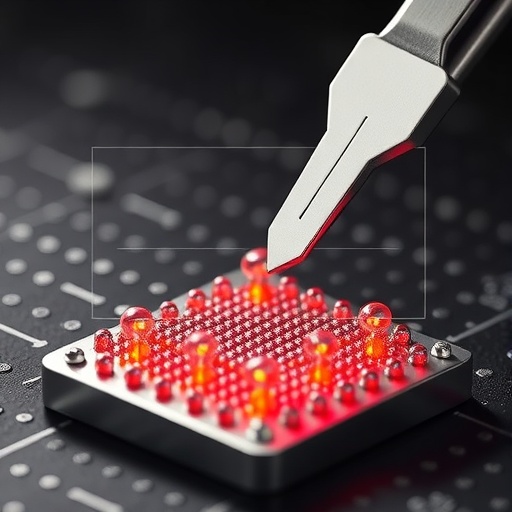
In a groundbreaking advancement that could reshape our understanding of strongly correlated electron systems, researchers have successfully engineered a doped quantum antiferromagnet using an innovative Rydberg tweezer array platform. This experimental feat tackles the longstanding challenge of simulating the complex physics of doped antiferromagnetic (AFM) Mott insulators, a cornerstone in investigating the mechanistic underpinnings of phenomena such as high-temperature superconductivity. The study offers unprecedented access to the intricate interplay between hole doping, spin interactions, and long-range tunneling processes, which together govern the exotic emergent phases in strongly correlated materials.
At the heart of this work lies the canonical t–J model—a theoretical framework capturing the competition between the kinetic energy of hole dopants, characterized by the tunneling amplitude t, and the AFM spin exchange interaction J. Traditionally, numerical simulations of this model have been constrained by formidable computational challenges, particularly in regimes of high particle density and complex geometry. The direct quantum simulation of t–J physics within a controllable experimental setup, therefore, represents a milestone in pushing the boundaries of quantum simulation towards solving practically relevant condensed matter problems.
The research team leveraged a Rydberg tweezer platform, manipulating arrays of atoms excited to high principal quantum number Rydberg states, to construct and control a bosonic t–J–V model with tunable parameters. By encoding spin states and vacant hole sites into coherent dynamics among three distinct Rydberg levels, they realized a highly flexible quantum simulator that accesses parameter regimes previously out of reach. Crucial to this approach was the incorporation of next-nearest-neighbor (NNN) tunneling terms, labeled as t′, which introduce subtle interference effects in hole motion and profoundly influence pairing dynamics and phase separation phenomena.
.adsslot_ApIgHZLYOz{width:728px !important;height:90px !important;}
@media(max-width:1199px){ .adsslot_ApIgHZLYOz{width:468px !important;height:60px !important;}
}
@media(max-width:767px){ .adsslot_ApIgHZLYOz{width:320px !important;height:50px !important;}
}
ADVERTISEMENT
One of the pivotal observations from the experiments was the spontaneous dynamical phase separation between hole-rich and spin-rich domains when the tunneling amplitude was much smaller than the spin interaction strength (|t/J| ≪ 1). Such phase separation reflects a delicate balance where kinetic restrictions encourage holes to cluster, thereby minimizing the frustration in the underlying antiferromagnetic order. This behavior echoes theoretical predictions about phase separation phenomena in doped Mott insulators but had remained elusive to direct observation in cold atom setups until now.
Beyond this, the experiments revealed compelling evidence for the formation of repulsively bound pairs of hole dopants. These pairs arise not from the conventional attraction but through an emergent binding mechanism mediated by the spin background and the interference between NNN tunneling paths and effective pair tunneling processes. This novel type of pairing, sensitive to the sign and magnitude of the nearest-neighbor hopping parameter t, distinguishes “light” and “heavy” pairs that exhibit markedly different mobility and coherence properties.
Using single-site addressability inherent to the Rydberg tweezer platform, the researchers were also able to probe the dynamics of individual holes embedded in two-dimensional square lattice magnets with both antiferromagnetic and ferromagnetic correlations. This capability to track single dopants in a complex, interacting spin environment provides an unparalleled window into the microscopic mechanisms underpinning charge and spin transport in correlated quantum materials. It represents a crucial step towards unraveling the fate of mobile carriers in strongly correlated backgrounds in real time.
Importantly, the model implemented in this experiment extends the scope of quantum simulation beyond conventional spin-1/2 frameworks to encompass spin-1 degrees of freedom as well as generalized t–J and t–J–V Hamiltonians. This versatility opens doors to studying a rich tapestry of quantum magnetism, charge dynamics, and unconventional pairing phenomena with tailored interactions. The bosonic nature of the holes and the fine control over near- and next-nearest neighbor interactions provide an experimental playground to explore exotic phases, including potential analogs of superconductivity and stripe order, within a fully coherent quantum environment.
The integration of coherent control, long coherence times, and flexible lattice geometries underscores the transformative potential of Rydberg tweezer arrays in simulating quantum many-body models that have remained largely theoretical. Their platform deftly surmounts the difficulties of competing energy scales and frustration effects, allowing for direct exploration of regimes where the kinetic and magnetic energy scales are carefully balanced. This is crucial for understanding how quantum phases compete, coexist, or evolve with doping in models relevant to high-Tc superconductivity and other correlated phenomena.
Moreover, the study’s detailed characterization of the interplay between NNN tunneling processes and perturbative pair tunneling illuminates the nuanced mechanisms by which complex hopping pathways affect microscopic pairing and mass renormalization of hole pairs. These insights shed light on longstanding conjectures about the role of second-neighbor hopping in stabilizing or suppressing superconducting correlations in the Hubbard and t–J models, providing fresh experimental benchmarks against which theoretical predictions can be tested.
By harnessing the unique capabilities of Rydberg-mediated interactions and site-resolved control, the work sets a new standard for quantum emulation of correlated electron systems. It bridges the gap between abstract theoretical models and tangible experimental realizations, offering a robust testbed for future studies to systematically investigate doping-dependent phase transitions, emergent quasiparticles, and the dynamical formation of correlations in two-dimensional lattice systems. This promises not only to deepen fundamental understanding but also to inspire novel quantum technologies leveraging strongly correlated quantum matter.
Looking forward, this pioneering realization of a doped quantum antiferromagnet is poised to invigorate experimental and theoretical inquiries into the rich physics of doped Mott insulators. As quantum simulation platforms continue to advance, they hold the promise of unraveling mysteries surrounding unconventional superconductivity, non-Fermi liquid behavior, and intertwined orders—all pivotal phenomena in modern condensed matter physics. The ability to engineer and probe such systems with unprecedented control may ultimately guide the rational design of materials with tailored electronic properties.
In conclusion, the innovative use of Rydberg tweezer arrays to emulate a bosonic t–J–V model with next-nearest-neighbor hopping marks a major leap forward in quantum simulation of strongly correlated systems. The experimental observation of phase separation, repulsively bound hole pairs, and the tunable dynamics of dopants in controlled spin environments is a testament to the power and precision of this approach. By extending the simulation paradigm beyond spin-1/2 models and into broader classes of quantum magnetism and charge dynamics, this work opens exciting new avenues for exploring the complex quantum many-body phenomena that underpin some of the most intriguing states of matter.
The findings not only provide immediate insights into longstanding theoretical puzzles but also establish a versatile platform capable of accessing novel, exotic quantum phases under experimentally tunable conditions. As the frontier of quantum simulation continues to expand, studies like this exemplify the critical synergy between advanced experimental techniques and theoretical frameworks, driving the field closer to unraveling the quantum secrets hidden within doped antiferromagnets and beyond.
Subject of Research: Quantum simulation of doped quantum antiferromagnets and strongly correlated electron systems using Rydberg tweezer arrays.
Article Title: Realization of a doped quantum antiferromagnet in a Rydberg tweezer array.
Article References:
Qiao, M., Emperauger, G., Chen, C. et al. Realization of a doped quantum antiferromagnet in a Rydberg tweezer array. Nature (2025). https://doi.org/10.1038/s41586-025-09377-1
Image Credits: AI Generated
Tags: antiferromagnetic Mott insulatorschallenges in numerical simulation of quantum systemsDoped quantum antiferromagnetexperimental quantum physics breakthroughshigh-temperature superconductivity researchhole doping and spin interactionslong-range tunneling processes in materialsmanipulating Rydberg states in experimentsquantum simulation of condensed matterRydberg tweezer technologystrongly correlated electron systemst–J model in quantum physics





